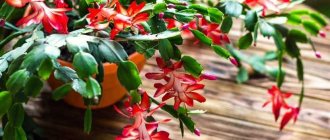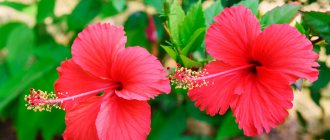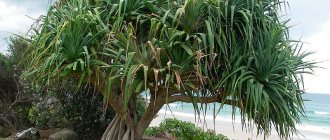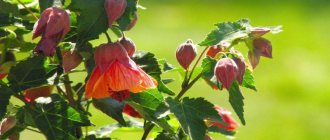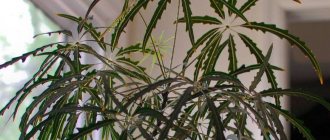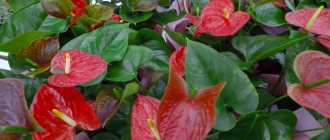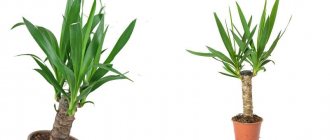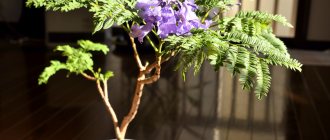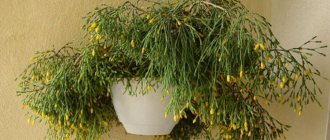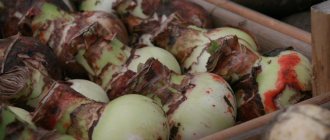The bright and beautiful Achimenes flower is a type of perennial ornamental plant. It came to us from the forest tropics of the central and southern parts of America. Among the many varieties of Achimenes, some are distinguished by their decorative properties.
Decorative indoor species of Achimenes are related to Saintpaulias and Gloxinias. Many people, growing achimenes at home, collect entire compositions from different species of this plant.
It gained its popularity not only due to its bright flowering, but also its duration. Throughout the growing season, the plant is strewn with flowers.
Types of indoor Achimenes plants and descriptions of their flowers
According to the type of growth, Achimenes are:
- Erect.
- Ampelous.
- Semi-ampelous.
Achimenes as an indoor flower can grow both straight and in an ampel. In the first case, the branches and shoots grow upward or sideways, and in the second, on the contrary, downward, and the plant sits in special flower pots. The third option is intermediate in terms of the direction of shoot growth.
Flowerpots are flower pots of medium diameter with a special mount for hanging. Such containers are good for climbing or bushy plants. In addition, they perfectly decorate the room without taking up space on the windowsill or table.
The description of the structure of Achimenes should begin with its main advantage - flowers. In shape they are similar to a “pipe” or “gramophone” with different petals - from rounded to “torn” edges. It blooms in summer with white, yellow, pink, purple or blue flowers. There are varieties with spotted, striped or two-colored inflorescences. All appearance features vary depending on the type and variety of the plant.
Large-flowered
Of all varieties - the largest. The height of the bush can reach 60 cm. Flowers with a diameter of up to 6 cm are drowned in abundant foliage.
The most detailed description of achimenesa of one type or another can be found in online catalogs.
Types and varieties of Achimenes: photos, names and descriptions
For detailed information, look at the list of names of popular varieties of Achimenes with the photos presented:
"Abendrot".
"Abyss"
"Adelaide".
"Alaska Dream"
"Amie Saliba"
"Amour"
This is not the entire list of varieties that deserve special attention; in fact, there are a large number of them. And all of them captivate plant growers with their unique flowering.
Despite the diversity in inflorescences, the plants are almost identical in structure. They have soft leaves with a ribbed, veiny surface and a pointed tip, and branched stems that fall slightly to the bottom.
Homemade varieties of Achimenes flowers have an unusual structure of the root system. They are characterized by rhizomes covered with scales, similar to small fir cones, with the help of which the plant reproduces. These scaly shoots are called rhizomes, and they are modified parts of normal roots.
The flowering period begins at the beginning of summer and lasts until autumn. And in winter, a dormant stage begins when the plant goes into hibernation.
Look at an example of the root system of a domestic achimenes flower in the photo below, which is presented for your reference:
There are many types of flowers known in indoor floriculture, but only a few of them are distinguished by their special participation in the development of varietal diversity of the crop. The main types of the Achimenes plant are:
- Long-flowered.
- Large-flowered.
- Mexican.
- Erect.
- Sweet.
- Lvinozevy.
- Snow-white.
- Prostrate.
It was they who served as the foundation for the emergence of the most popular and widespread varieties of this unique home flower.
Photos and a brief description of Achimenes species are presented below for your study.
Long-flowered Achimenes is a medium-sized species, reaching a height of 30 cm. The foliage and shoots are light green in color, the flowers are mostly light, reach a diameter of 4.5-5 cm, and grow one at a time.
Large-flowered Achimenes is a large species, capable of growing up to 0.6 m. The flowers are large - up to 7 cm in diameter, the leaves are slightly larger - up to 10-11 cm. It has a dark green bright color of foliage and shoots, flowers are usually larger rich colors. The main characteristic feature of the species is a small hollow formation at the base of the flower.
Indoor plants of Mexican achimenes reach a height of up to 35-45 cm, have straight shoots and medium-sized inflorescences. The bells are blue and purple with a white center with a yellow stripe. The leaves are dark green, oval shaped with one pointed end.
The erect species is quite large - up to 45 cm, with reddish shoots and small scarlet inflorescences. The main feature of the sweet species is the presence of a subtle delicate aroma. A medium-sized plant with light, small flowers (up to 4 cm in diameter) with a bright yellow core.
The flower of the lion's cape species, Achimenes , is small in size with a yellow center and a red pattern on it. The leaves are light green in color with a light downy coating.
The snow-white appearance has corrugated sheets with “torn” edges. The inflorescences are light white with a deep throat. The shoots are slightly red in color.
Varieties of indoor Achimenes are highly decorative. But some of them are especially unique. All thanks to the shapes and color palette of the inflorescences, which captivate all lovers of home vegetation.
Below are photos of upright varieties of Achimenes and their brief description.
“Milk and Honey” - the variety has straight shoots and medium-diameter flowers, with a milky terry corolla and a purple spot in the core. This is a miniature plant with very abundant and lush flowering.
"Kitty Elizabeth" - has straight-growing shoots, large, slightly double white inflorescences with blue tints. Its core is yellow, and the edge of the bud is wavy. The foliage is light green in color.
“Alaska Dream” - the variety has upright growing shoots and large, snow-white double flowers in diameter. The foliage is rich green with a zigzag edge.
You can see by looking at the photo that the Achimenes variety “Ballerina” has a bright and spectacular appearance:
They have straight-growing shoots and inflorescences of red-burgundy color. Their core is yellow, and the foliage is dark green with a reddish rim along the edge.
“Golden Lady” has straight shoots and medium-diameter flowers of a creamy color with one “extra” petal. Terry foliage, dark green.
"Raspberry Ripple" - straight, dark-colored shoots form a miniature plant. The flowers are delicate pink with a bright red edge and a yellow center.
One of the new varieties of Achimenes of British selection is called “Double Yellow” and amazes with its smooth coloring of yellow shades. These are large double flowers with a light yellow center and an orange border at the tips of the petals.
“Belas Memȯrias” - this variety has straight shoots and white-pink flowers with a purple center and fringed edges. Foliage is light green tones.
"Bird of Paradise" is a plant with slightly drooping shoots and dark leaves with a burgundy interior. The flowers are small, crimson in color with a yellow-brown-lilac throat in the center.
The flower of the stunning Achimenes variety "Tatjana Savсhuk" is suitable for cool rooms. It has a straight shoot structure and large flowers with a lilac corolla. The petals are wavy around the edge and yellow in the center.
“Blue Bird” is a flower variety with a bright blue color and large inflorescences. The structure of the shoots is straight, the petals are wavy with a white core and brown spots. An adult plant grows small in size - up to 30 cm in height.
What to do if sprouts appear early
If a flower retires early, it will also wake up prematurely. You just need to remember this to prevent unplanned germination. It is difficult to plant rhizomes with fragile shoots that have already hatched.
Also, Achimenes can leave the dormant state early:
- at a content of 18 °C and above;
- if during a cool winter the rhizomes were stressed by high temperatures, for example, they were moved from the balcony under the radiator for several hours.
In this case, some experienced gardeners break off the sprouts and store the rhizomes further. They determine at first glance that the rhizome is strong and healthy, it has enough strength and a supply of nutrients to put forward new shoots. It is not recommended for beginners to do this.
Not the best, but a reliable way is to move the achimenes to a cooler place and simply postpone planting. Then you will have to act very carefully so as not to break the sprouts. At first, such achimenes are looked after especially carefully.
Some gardeners claim that they place hatched rhizomes in the vegetable section of the refrigerator if the temperature there is not lower than 7-9 ° C. Achimenes can withstand 2-3 weeks with minimal losses. But not all varieties will survive in such conditions. This experiment can be performed only at your own peril and risk.
Even pots with achimenes should be checked during storage; it’s difficult to do anything with such sprouts
Ampel and semi-ampel varieties of Achimenes flowers
It is worth starting to describe the ampelous varieties of indoor Achimenes with the “Abendrot” variety. Amazing flowers resemble the shape of open rose buds. Large double inflorescences are painted in purple and pink tones. The leaves are slightly terry, light green in color.
"Adelaide" - has long shoots and large blue-blue flowers, the core is yellow. The leaves are light pink on the inside.
Pay attention to the ampelous Achimenes variety called “Little Beauty”: its photo is presented below.
As the shoots grow, they form a ball with a large number of large, bright pink pipe flowers. This variety is especially popular among plant admirers.
"Kim Blue" is a medium-sized plant that blooms profusely. Bright purple five-petaled inflorescences of large size frame long shoots. The foliage is red on the reverse side.
The description of semi-ampelic varieties of Achimenes should begin with the expressive variety “ Amour ” bred by S. Saliba. It stands out for its unusually bright pink flowers of small size. There are red-brown spots and stripes in the middle. Grows small in size.
'Dame De Paris' has medium-sized white flowers with a pink edge. The core is bright yellow and the leaves are dark green. Blooms long and profusely.
Proper care of Zaachimenes (with video)
Achimenes are not very demanding to care for and grow. By creating optimal conditions for their growth, abundant and regular flowering is ensured.
The flowering season for this plant is summer; in winter it “rests” and gains strength for the growth of new shoots and flowers. At the end of February and beginning of March, the flower “awakens” and the first shoots appear from the rhizomes. In its natural environment, Achimenes can bloom all year round, but in harsher cold climates, the heat-loving plant prefers to shed all its foliage and twigs and overwinter in a dark, dry place.
To care for achimenes at home, you need to pay attention to a number of environmental factors:
- Lighting.
- Temperature.
- The soil.
- Feeding.
- Watering.
- Trimming.
- Transfer.
The location likes light and warm, but not sunny, from spring to autumn. As with any indoor plant, light plays an important role. In a room that is too dark, the flower will experience a lack of lighting, and the process of photosynthesis will be absent, which will lead to the flower becoming faded and weak. Important! Avoid direct sunlight! If exposed to direct sunlight, the greens will dry out and become brittle. Therefore, the most favorable side for growing domestic achimenes is eastern or western. There will be no strong shadow or scorching rays, but gentle diffused light will contribute to long-term flowering and the vitality of the flower. During the dormant period, lighting requirements change. For wintering, you should remove the pot with the plant to a darker place.
Favorable temperature: +20…+25 °C. This is the most suitable temperature range for growing Achimenes flowers at home. It’s good to place pots on the veranda, balcony or terrace in the summer; they feel great in the fresh air. But it is important to prevent cold drafts from occurring; they have a detrimental effect on the health of the plant and can cause its disease and death, because This is a heat-loving type of home vegetation. During the dormant period, the temperature requirements are slightly different. The most favorable temperature range for wintering is +13…+15 °C. Under such conditions, the tubers will be well preserved and will not begin to germinate before the due time.
Another very important condition for growing Achimenes flowers is the type of soil and fertilizing.
- Recommended substrate: flower soil mixture.
- Time to fertilize: fertilize until the end of July.
For this plant, soil drainage plays a very important role, because... if its ventilation is insufficient, the humidity level will be too high, and there will be a risk of fungal infections due to stagnant water. The soil should be quite loose. Its components should be leaf, turf and sandy soil in a ratio of 3:2:1. Peat and humus soils can be added as an additive. Such mixtures can be purchased ready-made in specialized stores. Briquettes are sold with the mark “For decorative flowering plants.”
To make caring for Achimenes at home easier, watch the video below:
It describes in detail what factors influence the life of the plant and how to properly care for it in order to grow a flowering decoration for the home.
When the Achimenes retire
In adults or young grown from Achimenes rhizomes, the dormant period is pronounced. They will not vegetate in winter, no matter how intensively the owners water, illuminate and feed the contents of the pots. Yes, and you don’t need to do this.
Comment! Typically, the dormant period lasts 3-4 months, but in some varieties it can last up to six months.
Achimenes himself knows when to hibernate. It can “retire” in September-October, but sometimes vegetative processes die out in August or November. And they resume in February-March.
Read more Achimenes flower: care and propagation at home, photos, diseases and pests
The onset of the dormant period may vary from year to year. But the resumption of vegetation usually occurs after the same period of time. To calculate it, it is enough to observe the plant for 1-2 seasons.
Young Achimenes, propagated by seeds or cuttings, may “break tradition” in the first year and retire at the end of December or even later. Sometimes they continue the growing season in winter and go into hibernation in the spring. This usually happens when the flower has not had time to grow a rhizome. Over time, the “biorhythms” improve, Achimenes rests in short daylight hours, increases green mass and produces buds in long days.
Attention! Not all flowers grown from cuttings or seeds survive the first winter.
How to care for Achimenes: feeding and watering
To grow a healthy achimenes and properly care for it at home, take care of feeding it. It should be produced only during the period of active growth. And you should start feeding 1.5 months after the first sprouts from the tuber appear. You can purchase ready-made mixtures for fertilizing the soil of flowering plants at flower shops.
Watering: Starting in September, reduce watering to allow the plant to slowly wilt. At the end of the flowering period, the plant enters a dormant phase, which makes watering unnecessary. During wintering, excess moisture will only do harm, so lightly moistening the edge of the soil once a month will be quite enough. But for the flowering period this is catastrophically not enough. Here, abundant and regular watering is necessary to avoid drying out of the soil. It is best to do this 1-2 times a week with settled water at room temperature. Do not pour cold water under any circumstances, as this can cause shock and death to the plant. It is also allowed to humidify the air around the pot using a spray bottle - once a week.
Achimenes in nature and culture
In nature, exotics grow in the tropical forests of South and Central America. It belongs to the Gesneriaceae family and is a close relative of Saintpaulias, Streptocarpus and violets, popular among gardeners. Achimenes began to be grown as a cultivated plant in the 18th century. Today they decorate many gardens, greenhouses and home flower beds.
The beauty of the flowering of wild “brothers” of Achimenes can be observed all year round. At home, with proper care, the period of riot of colors lasts only up to six months, giving way to a state of rest.
These beautifully flowering perennials come in many varieties, differing in foliage shape, flower size and color. But they all have one thing in common - long creeping stems that effectively hang from the walls of the container, forming an openwork vertical carpet. Achimenes are famous for their abundant and lush flowering, which is replete with a wide palette of color shades.
Achimenes are among the heat-loving plants. This is indicated by the name of the culture, which when literally translated means “Achimenes” = “a” (no) + “chimenes” (cold).
Wintering Achimenes: how to store a flower in winter during the dormant period
Pruning: Trim dry parts of the plant. When preparing Achimenes for the period of winter dormancy, it experiences the death of flowers and leaves. This is due to the shedding of excess ballast before the sleep phase. Dried parts will only burden the flower and deprive it of useful microelements, which will be very necessary for maintaining the life of the rhizome in winter. Therefore, it is important to remove all dried shoots with a twisting motion to alleviate the condition of the flower after the growing season.
As for replanting the plant, it should be regular - once a year in early spring. Over the entire growing season, the soil is depleted and no longer has the rich composition of microelements necessary for plant life. Therefore, once a year at the end of February it is necessary to update the soil, but this must be done before the “awakening” of the flower begins. The rhizomes should be left in the pot until the end of February and then replanted.
Place rhizomes in new pots so that they are covered by 2 cm with new soil. Place in a warm, bright (not sunny) place. Water with warm water, take care of artificial air humidification. It is best to spray the air around the pot with a sprayer 1-2 times a week.
The wintering period of the Achimenes flower plays an important role in the life of the plant, because thanks to it it is able to sprout and bloom again. After a bright growing season with abundant flowering, a sleep phase follows, in which the tuber “rests” and accumulates useful microelements for the next flowering cycle. But that’s not all: during sleep, rhizomes are cut off in the rhizome, ready for reproduction and germination. The “hibernation” of a flower can last from 4 to 6 months, depending on the variety and storage conditions.
In order for the plant to survive the dormant period, you need to know how to store the Achimenes flower in winter. To prepare the plant for this phase, reduce the amount of daylight, reduce the amount of watering, and gradually reduce the temperature of the habitat. Under such conditions, the plant itself will naturally begin to “fall asleep”, and the process of rhizome formation will be activated. Lower temperatures promote the formation of flower rhizomes, with the help of which it reproduces.
In addition, such changes in environmental conditions will contribute to the death of flowers and shoots, relieving rhizomes of unnecessary burden. As a result, by the dormant period, the entire above-ground part of the plant dies off, and it is advisable to promptly remove the dead parts.
The root system is left in the ground throughout the winter, provided there is enough space for it to grow. Another way is to store rhizomes in bags or plastic containers. To do this, they are generously sprinkled with perlite to avoid the accumulation of moisture and the safety of rhizomes. This method is very convenient in terms of saving space and controlling the growth of the root system.
How to prepare Achimenes rhizomes for wintering
Forcibly retiring Achimenez is difficult, and it is not necessary. It can only be pushed to the end of the growing season or accelerate the process after the first signs appear:
- buds stop forming;
- The leaves begin to turn yellow, first of all the lower ones;
- The soil does not dry out longer after watering.
Preparing Achimenes for winter is as follows:
- in September the flower is no longer fed;
- First, gradually reduce watering, then stop altogether;
- the wilted flower is moved to a shaded place;
- After complete drying, cut off the above-ground part.
Important! Leaves and stems that have not completely died off should not be removed; they still contain plastic substances that help the rhizome to overwinter.
To prevent an unattractive-looking plant from spoiling the interior, it is removed behind the closet, placed on the mezzanine or under the bathroom.
With adult Achimenes trees that do not want to stop growing in December, you can do something radical - stop watering. For young plants grown from seeds or cuttings this season, this method is unacceptable. You will have to tinker with them until the leaves begin to dry out naturally, otherwise they will die.
More details Achimenes: names of varieties, photos of flowers
Achimenes are pruned and prepared for wintering after the above-ground part is completely dry.
Proper storage of Achimenes rhizomes in winter
Proper storage of rhizomes of Achimenes flowers in winter should take place at a temperature of +10 to +18 degrees. Watering and moistening the soil are not advisable, because... in combination with low temperatures can cause rotting of the root system and molding of the soil, which, in turn, will have a detrimental effect on the health of rhizomes and will make it impossible for both the reproduction and re-blooming of the plant. Therefore, when storing in bags, it is necessary to periodically air dry the contents in a cool place.
The rate of germination of Achimenes is influenced by how it was decided to store the rhizomes. At higher temperatures and high humidity, growth can begin as early as early spring, and at lower temperatures - at the beginning of summer.
Thus, you can regulate the life cycle of the plant yourself. But remember: the appearance of shoots too early and their germination in a dark place can lead to the cultivation of a weak flower with poor flowering.
Before you start growing new young achimenes, you should update the soil in order to ensure a supply of nutrients and minerals during the growing season. The flower will need them for healthy growth and an abundant flowering period.
Diseases and pests
If the plant is watered abundantly, a fungal disease begins to develop on the roots and shoots. If infected, there is a chance to save the plant. You should cut off the affected areas, treat them together with the soil with a fungicide and think about the conditions of care.
Insects such as aphids, spider mites and mealyworms are common problems. Pests should be eliminated with insecticides.
How to grow achimenes: propagation and flower care
Reproduction of the Achimenes flower can occur with the help of:
- Semyon.
- Cherenkov.
- Rhizome divisions.
- Listkov.
The first method is quite simple, because ready-made seeds can be bought in a specialized store or collected at home from an adult flower, if available. To collect homemade propagation material, you need to pollinate the inflorescences yourself. It's very simple: take a cotton swab or small brush and transfer pollen from the core of one flower to the pistil of another. Thus, artificial fertilization and the formation of seeds will occur, which can then be planted in the ground. The main thing is that this must be done at a temperature not lower than +20 degrees.
In summer, propagation of young Achimenes flowers is often carried out using apical cuttings. To do this, you need to cut off a healthy, strong stem, remove all the buds and top leaves, leaving only 1-2 pairs. After this, you can plant the treated shoot in the ground. It is advisable to cover the pot itself with a plastic bag or plastic bottle. Place the mini-greenhouse in a place with diffused lighting, and after 2-4 weeks you will see how the cuttings take root.
Propagation in spring is done by pieces of rhizomes or using rhizomes. The most effective, simplest way to propagate Achimenes, which does not require special care, is the method of dividing the rhizome. To do this, the root is cut into several pieces 4-5 cm long.
The cut sides are treated with charcoal, and then planted in fertile soil. The main nuance is that when dividing the root system, you need to take into account the presence of a sprouted shoot in each part.
Propagation of the Achimenes flower by rhizomes is not difficult in terms of cultivation and care. The main thing is to observe the temperature regime and the abundance of watering. When selecting specimens for planting, it is necessary to pay attention to their condition. It is better to throw away very dry and dark parts. And use medium-sized, light brown rhizomes as the starting material.
Reproduction using sheets is the most painstaking and time-consuming. It is rarely used, but it also has a right to exist. When choosing this method, it is necessary to select fleshy, healthy leaves and carefully cut them off. Plant in a pot with soil and peat moss, covered with a bottle or bag to create a greenhouse effect. The rooting period may take more than one week, but after this happens, the greenhouse can be removed and the plant can be grown in optimal conditions. Such a flower will be able to bloom in 1.5-2 years.
Reproduction of Achimenes
Reproduction of Achimenes, like all Gesnerievs, is possible in different ways, but two are more often used.
Growing Achimenes from seeds
Long way to bloom. At the end of February, fresh seeds are sown superficially. After spraying the soil, the container is covered with film (it is removed for watering and ventilating the seedlings). When shoots appear after 2.5 weeks, the film is removed. When 3 leaves are formed, the seedlings are planted in separate pots. Achimenes will bloom in a year.
Propagation of Achimenes by cuttings
A popular option for propagating rare species. A cutting of at least 5 cm in length is cut from the tops. The lower leaves are removed and placed in warm water with the addition of charcoal powder. In the light, the roots will appear after about 10 days. The rooted cuttings are planted in the ground. Can be propagated by leaf cuttings. The leaf is placed in moistened soil and covered with film. When the roots appear, they are planted in a separate pot. After a few months, the pot is changed to a larger one. If buds appear in the first year, they must be cut off: the task of achimenes at this time is the formation of rhizomes.
Seed propagation leads to the loss of varietal originality of the plant, so it is rarely used.

